Berwickshire
| Berwickshire United Kingdom | |

| |
|---|---|
| Flag | |
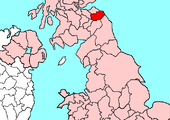
| |
| [Interactive map] | |
| Area: | 457 square miles |
| Population: | Template:Hcspop |
| County town: | Berwick or Duns |
| County flower: | Rock-rose [1] |
The County of Berwick is a shire on the River Tweed. It is part of the "Middle Shires".
Berwickshire is a lowland shire, along the border of England and Scotland. The River Tweed forms its southern boundary with Northumberland. Berwickshire can be divided into three areas; the Merse being the fertile lands along the Tweed, Lauderdale in the westerly part of a dale with cuts into the Lammermuir Hills, where the River Leader runs, and finally the Lammermuir Hills, the ridge of hills separating Berwickshire from East Lothian. Lammermuir reaches 1,746 feet in Berwickshire, at Meikel Says Law on the boundary of East Lothian.
The name of Berwickshire is first found it the Charters of King David I[1] but might have been founded earlier. The shire is named after its former county town, the royal burgh of Berwick-upon-Tweed, which might be claimed by Berwickshire, but the town was sundered by force from its shire by the English in 1174 and changed hands repeatedly during the wasteful wars which rove this island during the Middle Ages, until in 1482 it was finally taken by the English, subsequently becoming attributed to the county of Northumberland.
The lie of the land
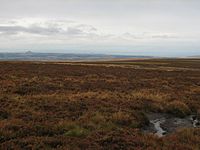
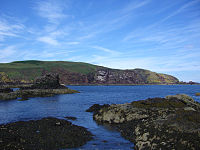
Berwickshire has the fells of Northumberland to the south, East Lothian to the north and to the west are Roxburghshire and Midlothian. The River Tweed forms the boundary with Northumberland and its eastern edge is its 21-mile cliff-bound coastline on the North Sea.
The county is naturally divided into three districts:
- Lauderdale is the valley of the River Leader in the west;
- Lammermuir is the high moorland overspread with the Lammermuir Hills
- The Merse is largest part of the shire, occupying the southeast, its name meaning "the March" or "Borderland".
The Lammermuir Hills are a range of round-backed hills, whose average height is about 1,000 feet, and here is found the highest point in the county, the shoulder of Meikle Says Law (1,749 feet). The hills reach up to the border of the Lothians, separating the Middle Shires from the counties on the Forth.
The Merse stretches to the south and east, and is a comparatively level landscape.
The coastland is lofty, rocky and precipitous, broken by ravines and not accessible, except at Eyemouth Harbour, where small vessels may dock, and at Coldingham and Burnmouth for fishing boats. Eyemouth in particular is famous for its fishing fleet. St Abb's Head near Coldingham juts into the sea, guarded by a lighthouse.
Rivers
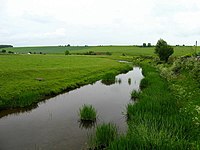
Berwickshire's greatest river is its border river; the River Tweed, which is tidal as high as the Union Bridge at Tweedhill (above Paxton, Berwickshire).
The River Eye is the only river of any size which falls directly into the sea. The others, the River Leader, the Eden, the Leet and the Whiteadder with its tributaries, the Blackadder. The Whiteadder is the largest tributary river of the county, rising in the Lammermuir Hills in East Lothian and flowing 35 miles to joins the Tweed outside Berwick.
History
Traces of Roman occupation and of ancient British settlement exist in various parts of the Merse. Edin's or Etin's Hall, on Cockburn Law, 4 miles north of Duns, is still called the Pech's or Pict's House, and is one of the very few brochs found in the Lowlands. Known history though begins after the collapse of Roman power.
From the late fifth or early sixth century, all the lands to become Berwickshire formed part of the English kingdom of Northumbria, which stretched from the River Forth to the Humber. The folk of the Tweed were converted to Christianity through the missionary efforts of Modan in the 6th century, and by King Oswald and by Aidan and Cuthbert in the 7th centuries. Cuthbert is traditionally believed to have been born in Lauderdale. In about 650, Ebba, daughter of King Æthelfrith of Northumbria, founded the nunnery at Coldingham. The adjoining promontory of St Abb's Head was named after her.
The Norse invaded Britain in force in the eighth century, but the rugged coast proved an effectual barrier to their attacking Berwickshire. The place-names of Berwickshire are still overwhelmingly English, with little Norse influence. Norse names begin to prevail south of the Tees in Yorkshire, while here the English remnant of the Northumbrians held out against the wild men from the sea. In 886 though, the Vikings destroyed Coldingham.
At some time in the early eleventh century, possibly after the battle of Carham in 1018, the lands north of the River Tweed were annexed by Malcolm II, King of the Scots. Birgham, 35 mile west of Coldstream, was the scene of the conference in 1188 between William the Lion and the bishop of Durham, which discussed the attempt of the English church to assert supremacy over the Scottish bishops. Here also met in 1289 a convention of the Scots estates to consider the projected marriage of Prince Edward of England to the Maid of Norway; and here was signed in 1290 the treaty of Birgham, assuring the independence of Scotland. During the long period of international strife the shire was repeatedly overrun by armies of the English and Scots kings, who were constantly fighting for the ancient frontier town of Berwick. It was finally ceded to England in 1482, and the people afterwards gradually settled down to peaceful pursuits. The ford at the confluence of the Leet and Tweed near Coldstream gave access to south-eastern Scotland. Edward I crossed it with his army in 1,296, encamping at Hutton the day before the siege of Berwick, and it was similarly employed as late as 1640, when the Marquess of Montrose led the Covenanters on their march to Newcastle, although James VI had already caused a bridge to be constructed from Berwick to Tweedmouth. There are several places of historic interest in the county.
Upon the site of the nunnery at Coldingham, King Edgar in 1098 founded a Benedictine priory, which was one of the oldest monastic institutions in Scotland and grew so wealthy that James III annexed its revenues to defray his extravagance, a step that precipitated the revolt of the nobles in 1488. The priory was seriously damaged in the earl of Hertford's inroad in 1545, and Cromwell blew part of the church up in 1650. The chancel (without aisles) was repaired and used as the parish church. The remains contain some fine architectural features, such as, on the outside, the Romanesque arcades surmounted by lancet windows at the east end, and, in the interior, the early pointed triforium.
In the Middle Ages and into the modern period, Berwickshire was an unquiet land, the haunt of robbers like som much of the borderlands. In 1603 however, King james VI ascended the throne of England also and thus uniting the two lands in his person he could enforce order without regard to borders, a task entrusted to a Berwickshire man, the Earl of Dunbar. Dunbar's pacification of the borders was met with great success and allowed Berwickshire to achieve prosperity. Thenceforth, the borderlands were to be named "the Middle Shires".
Towns and villages
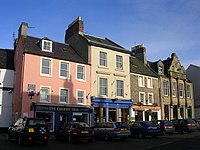
Towns
- Greenlaw
- Coldstream (burgh)
- Duns (burgh)
- Eyemouth (burgh)
- Lauder (royal burgh)
Larger villages
Parishes
Sights of Berwickshire
Media
The Berwickshire News is published weekly.
Big Society
Numerous organisations and groups operate across Berwickshire and many are proud to bear the name of Berwickshire in their titles. The Berwickshire Civic Society is a civic sociaety for the county. It os campaigning for road signs at the entrances to the old county to have notices added saying 'You are now entering the ancient county of Berwickshire'. It holds an annual Keep Berwickshire Tidy Campaign, judged each April.
References
- ↑ Brown, D (ed.): Early Scottish Charters
| Counties of the United Kingdom |
|---|
|
Aberdeen • Anglesey • Angus • Antrim • Argyll • Armagh • Ayr • Banff • Bedford • Berks • Berwick • Brecknock • Buckingham • Bute • Caernarfon • Caithness • Cambridge • Cardigan • Carmarthen • Chester • Clackmannan • Cornwall • Cromarty • Cumberland • Denbigh • Derby • Devon • Dorset • Down • Dumfries • Dunbarton • Durham • East Lothian • Essex • Fermanagh • Fife • Flint • Glamorgan • Gloucester • Hants • Hereford • Hertford • Huntingdon • Inverness • Kent • Kincardine • Kinross • Kirkcudbright • Lanark • Lancaster • Leicester • Lincoln • Londonderry • Merioneth • Middlesex • Midlothian • Monmouth • Montgomery • Moray • Nairn • Norfolk • Northampton • Northumberland • Nottingham • Orkney • Oxford • Peebles • Pembroke • Perth • Radnor • Renfrew • Ross • Roxburgh • Rutland • Selkirk • Shetland • Salop • Somerset • Stafford • Stirling • Suffolk • Surrey • Sussex • Sutherland • Tyrone • Warwick • West Lothian • Westmorland • Wigtown • Wilts • Worcester • York |